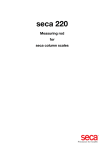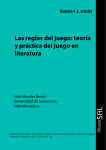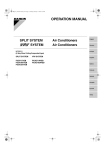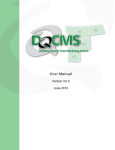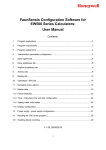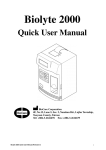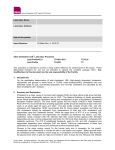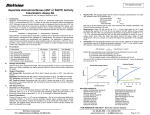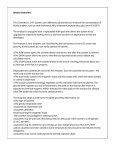Download ALT•AST (GPT•GOT)
Transcript
ALT•AST (GPT•GOT) Alanine Aminotransferase (Glutamate Pyruvate Transaminase) and Aspartate Aminotransferase (Glutamate Oxaloacetate Transaminase) Test Cassette 12-788 CLIA WAIVED - This test is waived under CLIA’88 regulations. Each laboratory or testing site using this test system must have a CLIA Certificate of Waiver. To obtain a Certificate of Waiver, refer to CMS website (http://www.cms.hhs.gov/CLIA/) or Cholestech (www.cholestech.com) for an application. Laboratories must follow the manufacturer’s instructions. If a laboratory modifies the test system instructions, then the test is considered high complexity and subject to all CLIA requirements. Cholestech LDX and the Inverness Medical logo are registered trademarks of the Inverness Medical group of companies. MiniPetTM is a trademark of TriContinent Scientific, Inc. © 2010 Inverness Medical. All rights reserved. 22959en Rev. A Protected by patents US 5110724; other rights granted and pending. Biosite Incorporated 9975 Summers Ridge Road San Diego, CA 92121 U.S.A. Tel 1.877.441.7440 Fax 1.321.441.7400 www.cholestech.com MDSS GmbH Schiffgraben 41 30175 Hannover Germany aspartic acid to oxaloacetate. Both are found in cardiac and skeletal muscle, the liver, and other tissues. ALT is most prevalent in the liver. ALT and AST levels are a reflection of alterations in liver function and therefore are a valuable measurement of damage to the liver. Liver damage may be due to chronic alcohol or drug ingestion, or infection. There are a number of lipid-lowering drugs available to treat hyperlipidemia. A side effect of such therapy can be a persistent increase in serum ALT and/or AST (to more than 3 times the upper limit of normal) in about 1% of patients receiving lipid-lowering therapy. It is suggested that patients undergoing lipid-lowering drug therapy should be tested for ALT and AST before (baseline) and shortly after initiation of therapy and then periodically thereafter to determine the ALT and AST levels. Alanine aminotransferase and aspartic acid aminotransferase can be measured from a single drop of blood using the Cholestech LDX System’s rapid, accurate technology. An AST/ALT ratio is calculated using the measured values. The Cholestech LDX System combines enzymatic methodology and solid-phase technology to measure ALT and AST. Samples used for testing can be whole blood from a fingerstick (collected in a heparin-coated capillary tube) or venous whole blood. The sample is applied to a Cholestech LDX ALT/AST cassette. The cassette is then placed into the Cholestech LDX Analyzer where a unique system on the cassette separates the plasma from the blood cells. The plasma flows to both sides of the cassette and is transferred to the ALT and AST reaction pads. The Cholestech LDX Analyzer measures alanine aminotransferase by an enzymatic method based on the method formulation of Katsuyama et al.1,2 Alanine aminotransferase catalyzes the transfer of amino groups from L-alanine to alphaketoglutarate, producing pyruvate and glutamate. Pyruvate oxidase, in the presence of oxygen, oxidizes the pyruvate to acetylphosphate and hydrogen peroxide. In a reaction catalyzed by horseradish peroxidase, the peroxide reacts with an indicator dye to form a blue color at a rate proportional to the ALT concentration of the sample. The resultant color in the reaction is measured by reflectance photometry. Pyruvate + Phosphate + O2 + H2O Indicator + H2O2 Refer to the CD in the Cholestech LDX® analyzer package for instructions in English. The instructions are also available from your local distributor Le CD contenu dans l’emballage de l’analyseur Cholestech LDX inclut les directives d’utilisation en français. Le mode d’emploi est également disponible auprès du distributeur local. Anweisungen auf Deutsch befinden sich auf der CD in der Verpackung des Cholestech LDX-Analysegeräts. Die Anleitung ist auch von Ihrem Händler erhältlich. Fare riferimento al CD nella confezione dell’analizzatore Cholestech LDX per istruzioni in italiano. Le istruzioni sono disponibili presso il distributore di zona. Consulte el CD incluido en el envase del analizador Cholestech LDX para obtener instrucciones en español. También puede pedir las instrucciones a su distribuidor local. Consulte o CD no pacote do analisador LDX Cholestech para instruções em português. As instruções estão disponíveis junto do seu distribuidor local. Der henvises til den vedlagte CD i Cholestech LDX-analysatorpakken for instruktioner på dansk. Instruktionerne fås hos den lokale forhandler. Se CD:n i Cholestech LDX-analysatorförpackningen beträffande instruktioner på svenska. Instruktionerna finns att få hos din lokala återförsäljare. Hvis du vil ha flere instruksjoner, kan du se CDen som følger med i Cholestech LCX-analysatorpakken. Instruksjonene fås også hos din nærmeste forhandler. Türkçe talimat için Cholestech LDX Analizör paketindeki CD’ye bakınız. Talimat yerel distribütörünüzden elde edilebilir. Ανατρέξτε στο CD στη συσκευασία του Αναλυτή Cholestech LDX για οδηγίες στα Ελληνικά. Οι οδηγίες είναι διαθέσιμες από τον τοπικό διανομέα σας. Pokyny v angličtine získate z disku CD, ktoré sa nachádza v balíku analyzátora Cholestech LDX. Pokyny môžete tiež získať od miestneho distribútora. INTENDED USE An in vitro diagnostic for the quantitative determination of alanine aminotransferase (ALT) and aspartate aminotransferase (AST) in whole blood. SUMMARY AND EXPLANATION Alanine aminotransferase is an enzyme that catalyzes the conversion of alanine to pyruvate. Aspartic acid aminotransferase is an enzyme that catalyzes the conversion of Alanine Aminotransferase Pyruvate + Glutamate Pyruvate Oxidase Acetylphosphate + CO2 + H2O2 Peroxidase Colored Blue Dye + H2O The Cholestech LDX Analyzer measures aspartate aminotransferase by an enzymatic method based on the method formulation of Katsuyama et al.1,2 Aspartic acid aminotransferase catalyzes the transfer of amino groups from L-Aspartic acid to alphaKetoglutarate producing oxaloacetate and glutamate. Oxaloacetate Decarboxylase converts the Oxaloacetate to Pyruvate by the removal of CO2. Pyruvate oxidase, in the presence of oxygen, oxidizes the pyruvate to acetylphosphate and hydrogen peroxide. In a reaction catalyzed by horseradish peroxidase, the peroxide reacts with an indicator dye to form a blue color at a rate proportional to the AST concentration of the sample. The resultant color in the reaction is measured by reflectance photometry. Aspartate Aminotransferase L-Aspartic acid + alpha-Ketoglutarate Oxaloacetate+ Glutamate Oxaloacetate Decarboxylase Oxaloacetate Pyruvate + CO2 Pyruvate Oxidase Pyruvate + Phosphate + O2 + H2O Acetylphosphate + CO2 + H2O2 Peroxidase Indicator + H2O2 Colored Blue Dye + H2O A brown magnetic stripe on each cassette contains the calibration information required for the Cholestech LDX Analyzer to convert the reflectance reading to the ALT and AST concentrations in U/L, 37°C (99°F). REAGENTS AND MATERIALS Cholestech LDX Analyzer and power supply Alcohol swabs and gauze for cleaning puncture site Lancets for capillary blood collection Cholestech LDX 35 µL Capillary Tubes (with lithium heparin anticoagulant) Cholestech LDX Capillary Plungers Gloves Biohazard waste containers Quality control material MiniPetTM Pipette and tips or micropipetter that will deliver 35 µL for use with venipuncture samples and quality control material •Vacuum collection tubes, needles, tube holders and sample tubes if the sample is to be collected by venipuncture For professional in vitro diagnostic use only. All blood samples, containers, capillary tubes and materials that have come in contact with blood should be handled as if capable of transmitting infectious disease and discarded into a biohazardous waste container after use. STORAGE AND HANDLING Cassette Storage and Stability Cassettes must be stored in the sealed foil pouches. Place cassettes in the refrigerator after receipt. Cassettes may be used until the date printed on the pouch when stored in a refrigerator (36-46°F / 2-8°C). The cassettes may be stored for up to 30 days at room temperature (48-86°F / 9-30°C). The new expiration date is the date the cassettes are placed at room temperature plus 30 days. Write the new expiration date on the side of the cassette box in the space provided. IMPORTANT: Once the cassettes have been stored at room temperature, they should not be returned to the refrigerator. • Do not use a cassette beyond the printed expiration date. • Do not use a cassette that has been stored at room temperature for more than 30 days. • Do not reuse cassettes. Cassette Handling Cassettes should sit at room temperature for 10 minutes before opening the pouch. Use the cassette as soon as the pouch is opened. SPECIMEN COLLECTION AND HANDLING Sample Type The Cholestech LDX System is CLIA waived for fingerstick or venous whole blood unprocessed samples only. If you run serum or plasma on the Cholestech LDX System you will have to comply with the regulations for moderate complexity. See the Cholestech LDX System User Manual for a summary of these regulations. Sample Requirement An Optics Check should be run on the Analyzer each day that patient samples are tested. See the Cholestech LDX User Manual for instructions. WARNING: Squeezing the finger excessively may cause inaccurate test results. Fingerstick Procedure 1. 2. The patient should sit quietly for five minutes before the blood sample is collected. Put a capillary plunger into the end of a Cholestech LDX 35 μL Capillary Tube with the red mark. Set aside. 3. Choose a spot that is on the side of one of the center fingers of either hand. The fingers and hands should be warm to the touch. To warm the hand, you can: a. Wash the patient’s hand with warm water, or… b. Apply a warm (not hot) compress to the hand for several minutes, or… c.Gently massage the finger from the base to the tip several times to bring to blood to the fingertip. 4. Clean the site with an alcohol swab. Dry thoroughly with a gauze pad before pricking the finger. 5. Firmly prick the selected site with a lancet. 6. Squeeze the finger gently to obtain a large drop of blood. Wipe away this first drop of blood as it may contain tissue fluid. 7. Squeeze the finger gently again while holding it downward until a second large drop of blood forms. Do not milk the finger. The puncture should provide a freeflowing drop of blood. 8. Hold the capillary tube horizontally or at a slightly descending angle by the end with the plunger. Touch it to the drop of blood without touching the skin. The tube will fill by capillary action to the black mark. Do not collect air bubbles. If it is necessary to collect another drop of blood, wipe the finger with gauze then massage again from base to tip until a large drop of blood forms. 9. Fill the capillary tube within 10 seconds. 10. Wipe off any excess blood from the finger and have the patient apply pressure to the puncture until the bleeding stops. Use this procedure to apply a venous blood sample, or control, calibration verification or proficiency testing materials to the cassette. Any pipette that can deliver 35 µL may be used. 1. Firmly attach the pipette tip to the end of the 35 µL MiniPet Pipette. Use a new tip for each sample. 2. To fill the pipette, push the plunger down as far as you can. Place the pipette tip midway into the sample and slowly release the plunger. Confirm that no air bubbles are in the pipette tip. 3. Place the pipette tip into the cassette sample well. Dispense the sample into the cassette sample well by pressing the plunger down. Move the pipette tip out of the sample well before releasing the plunger again. 4. Remove the pipette tip and throw it away in a biohazard waste container. IMPORTANT: If the plunger is released before the pipette tip is out of the sample well, it will remove the sample just dispensed. IMPORTANT: Keep the cassette horizontal at all times after applying the sample. Running a Test If the cassettes have been refrigerated, allow them to come to room temperature (at least 10 minutes) before opening. Fingerstick whole blood 2. Make sure the Analyzer is plugged in and has warmed up. 3. Remove the cassette from its pouch. Hold the cassette by the short sides only. Do not touch the black bar or the magnetic stripe. Place the cassette on a flat surface. • • IMPORTANT: Gloves should be worn whenever working with blood samples. • Sample Volume: 35 µL of whole blood. Collect the sample from a fingerstick into a Cholestech LDX 35 µL Capillary Tube. (See the Fingerstick Procedure below). Place the blood into the cassette within 5 minutes after collection. Blood from the fingerstick should flow freely. Too much squeezing of the finger may cause poor results. 4. • Cholestech LDX ALT•AST Cassettes Selftest running. Collect blood into a green-top tube (heparin anticoagulant). IMPORTANT: Do not use a tube with any other additives because it may cause inaccurate results. ALT 24.5 - 2.43 2.93 - 0.64 0.96 0.53 AST 26.0 2.43 3.08 0.11 0.67 1.01 0.56 2.36 2.36 • • • • Use a MiniPet Pipette and tip to place blood into the cassette. Whole blood should be used within 30 minutes. Samples should be at room temperature for testing. Mix all samples by inverting gently 7–8 times before testing. TEST PROCEDURE Calibration No calibration is performed by the user. Test information is encoded on the brown stripe of the cassette. The brown magnetic stripe is read by the Cholestech LDX Analyzer each time a cassette is run. Press RUN. The Analyzer will do a selftest, and the screen will display: Selftest OK Place the sample into the cassette well. Use a Cholestech LDX Capillary Tube for fingerstick samples. Use a 35 µL MiniPet Pipette for venous blood samples and quality control, calibration verification, and proficiency testing materials. IMPORTANT: Fingerstick samples must be applied within five (5) minutes or the blood will clot. 7. Keep the cassette flat after the sample has been applied. WARNING: Allowing the sample to sit in the cassette will cause inaccurate results. Immediately place the cassette into the drawer of the Analyzer. The black reaction bar must face toward the Analyzer. The brown magnetic stripe must be on the right. 8. DO NOT PUSH IN THE DRAWER. Press RUN. The drawer will close. During the test, the screen will display: ALT-AST Test Running*** 9. Put everything that touched the blood samples or control, calibration verification, or proficiency testing material into a biohazardous waste container. 10. When the test is complete, the Analyzer will beep, and the screen will display: ALT=### AST=### AST/ALT=### Using the Cholestech MiniPet Pipette 1. • 6. IMPORTANT: A warm hand and good blood flow from the puncture site are essential in order to collect a good capillary sample. Venous whole blood Materials Provided Each ALT•AST Cassette contains a minimum of: L-Alanine, µg L-Aspartic acid, µg alpha Ketoglutaric acid, µg Sodium phosphate monobasic, µg Oxaloacetate decarboxylase, U Pyruvate oxidase (Aerococcus viridans), U Peroxidase (horseradish), U Ascorbate oxidase (Cucurbita sp.), U (Indicator) 2-(3,5 di-tert-butyl-4-hydroxyphenyl) 4,5-bis (4-dimethylaminophenyl)imidazole, µg Nonreactive ingredients: buffers and stabilizers • • • • • • • • • PRECAUTIONS PRINCIPLES OF THE PROCEDURE L-Alanine + alpha-Ketoglutarate Materials Required But Not Provided 11. Press DATA to view additional results. 12. When the results are outside the measuring range of the test, the screen will display: [Test Name]>400 or [Test Name]<10 13. If there is a problem with the test, a message will appear on the screen. See the Troubleshooting section of the Cholestech LDX System User Manual if this happens. Please call Cholestech Technical Service at 1.877.441.7440 or 1.321.441.7200 to report any problems or if you have questions about the operation of the Cholestech LDX System. 14. When the drawer opens, remove the cassette, and put it in a biohazardous waste container. Leave the Analyzer drawer empty when not in use. 15. Record the results on the appropriate form. 16. To run another cassette, press RUN. The screen will display: Load cassette and press RUN. 17. Repeat step 3, and steps 6 through 15. IMPORTANT: If you do not want to run another test and the drawer is open, press STOP to close the drawer. 18. Otherwise, after four minutes a beep will sound and the screen will display: 5. The cassette drawer will open, and the screen will display: Load cassette and press RUN. System timeout RUN to continue 19. If necessary, press the DATA button to view the results from the last cassette used. IMPORTANT: Pressing the RUN button will erase the previous result. QUALITY CONTROL PERFORMANCE CHARACTERISTICS External quality control material should be run routinely to show that your system is giving accurate results. We recommend the following quality control procedures for the Cholestech LDX System. Precision Choice of Materials Liquid Level 1 and Level 2 controls that work well with the Cholestech LDX System are available. If you use other controls, you will need to establish ranges for the Cholestech LDX System. Handling • • • A study was conducted according to NCCLS protocol EP5-A, Evaluation of Precision Performance of Clinical Chemistry Devices; Approved Guideline (1999).4 Alanine Aminotransferase Commercial Control Material Level 1 X (U/L) = Within run %CV Total %CV Follow the instructions that come with your controls. Check the expiration date before use. Do not use if expired. See “Running a Test” for the procedure. External Quality Control External control material should be used to demonstrate that the reagents and the assay procedure perform properly. Good Laboratory Practice principles suggest that controls should be run whenever the laboratory director has any question about test system integrity, reagent storage conditions, or the reliability of any test result. If the controls do not perform as expected, repeat the test or contact Cholestech Technical Service before testing patient samples. Controls should be tested: • With each new lot of cassettes; • With every new shipment of cassettes, even if the lot has been received previously; • When reagents may have been stored or handled in a way that can degrade their performance; • As otherwise required by your laboratory’s standard quality control procedures; • As otherwise required by federal, state and local guidelines. X (U/L) = SD (U/L) = %CV = ALT and AST test results will be displayed on the screen when the test is complete. Calculated results are displayed after the DATA button is pressed. LIMITATIONS • • The measuring range for ALT is 10 – 400 U/L, 99°F / 37°C. Results outside this range will appear as <10 U/L or >400 U/L. The measuring range for AST is 10 – 400 U/L, 99°F / 37°C. Results outside this range will appear as <10 U/L or >400 U/L. Performance of the Cholestech LDX System has not been tested on samples from newborns or pediatric patients. Hemolysis, breakdown of the red blood cells, should be avoided as this will increase the level of ALT and AST and cause inaccurate results. Samples with ALT or AST enzyme activity greater than 1000 U/L may consume the substrate prior to the measurement of enzyme activity and could yield falsely low results. Some substances may cause false results with enzymatic tests. The substances listed below were tested for interference with the ALT•AST test. Less than 10% interference was seen at the levels shown. Substance Concentration (mg/dL) Ascorbic Acid 1 Bilirubin 5 Creatinine 30 Cysteine 7 Ditaurobilirubin 5 Fructose 30 Gemfibrozil (Lopid) 15 Glutathione 1 • 58 3.1% 4.6% 169 3.4% 6.5% 31 6.1% 8.8% Commercial Control Material Level 2 Frozen Serum Pool 106 3.5% 4.4% 277 3.8% 5.2% Whole Blood Within-run Precision Hemoglobin Lactate Lactose Lovastatin (Mevacor) Nicotinic Acid (Niacin) Urea Uric Acid 75 100 100 4 10 500 15 Venous Whole Blood Serum Fingerstick Alanine Aminotransferase Reference Interval, 99°F/37°C3 Males 10-40 U/L Females 7-35 U/L Aspartate Aminotransferase Reference Interval, 99°F/37°C3 Males 15-40 U/L Females 13-35 U/L Range of Values 0.966 0.960 0.930 10 - 349 14 - 391 15 - 65 Correlation Coefficient Range of Values 0.916 0.914 0.921 0.3 0.5 4.3 0.975 0.971 0.931 10 - 349 19 - 383 15 - 65 Asparate Aminotransferase X = Comparison Method (serum) Y = Cholestech LDX Analyzer Serum EXPECTED VALUES Correlation Coefficient AST measured using the Cholestech LDX cassette was compared with a validated comparison method traceable to the IFCC reference method. Sample Type Hematocrits between 30% and 50% do not affect results. -0.3 2.8 3.5 No. of Pairs Slope y-intercept 53 52 24 No. of Pairs Slope y-intercept 109 0.97 Range of Values 0.998 0.934 13 - 343 13 - 65 0.3 4.4 ALT Consumer Accuracy Study (trained [x-axis] vs untrained [y-axis]) n Slope 60 0.976 Slope 95% confidence interval y-intercept 0.934 to 1.019 N Observed Range 1.001 1.007 1.013 1.08 0.86 Correlation Coefficient per uso diagnostico in vitro usage diagnostique in vitro utilização em diagnóstico in vitro •För diagnostisk användning in vitro •Til in vitro-diagnostisk brug •Medisinsk utstyr for in vitro-diagnostikk •In Vitro tanısal tıbbi cihaz •Гια in vitro διαγνωστική χρήοη •Na in vitro diagnostické použitie •Pour •Para 1.6 Correlation Coefficient Range of Values 0.983 12 - 396 Number de catálogo •Katalognummer •Numero di catalogo de catalogue de catálogo •Katalognummer •Katalognummer •Katalognummer •Katalog numarası •Αριθμός καταλόγου •Katalógové číslo •Numéro •Número •Caution, consult accompanying documents Consulte los documentos adjuntos lesen Sie die beigelegten Dokumente •Attenzione. Consultare la documentazione in allegato •Attention ! Consulter les documents joints •Atenção. Consulte as instruções de utilização •OBS! Se bruksanvisningen •Forsigtig, læs medfølgende dokumenter •Forsiktig, se medfølgende dokumentasjon •Dikkat, beraberindeki belgelere bakın •Προσοχή, συμβουλευτείτε τα συνοδευτικά έγγραφα •Pozor. Pozri návod na používanie •Precaución. •Achtung, ALT Waiver Data % CV X = Bench-top Point-of-care Analyzer Y = Cholestech LDX Analyzer Sample Type 46 21 Mean No. of Pairs Slope y-intercept 53 54 24 Venous Whole Blood Fingerstick •Número •Esclusivamente y-Intercept 95% confidence interval r -1.4 to 3.3 0.996 1.0 •Do •Do •Lot •Nicht •Nicht •Chargennummer not reuse reutilizar zur Wiederverwendung •Non riutilizzare •Ne pas réutiliser •Não reutilizar •Återanvänd ej •Må ikke genbruges •Til engangsbruk •Tekrar kullanmayın •Μην επαναχρησιμοποιείτε •Nepoužívajte opakovane •No An “untrained user” study was conducted in which participants were given only the test instructions and asked to perform testing of 3 blinded randomized samples. The samples consisted of serum pools prepared at three levels. The participants were not given any training on the use of the test. A total of 72 participants were enrolled from three sites, representing a diverse demographic (educational, age, gender, etc.) population. The table below presents the summary of the performance: 58 2.8 4.8% Alanine Aminotransferase X = Comparison Method (serum) Y = Cholestech LDX Analyzer Venous Whole Blood Serum Fingerstick No. of Pairs Slope y-intercept •Catalog uso diagnóstico in vitro •In-vitro-Diagnostikum AST Waiver Data ALT measured using the Cholestech LDX cassette was compared with a validated comparison method traceable to the IFCC reference method and with a bench-top point-of-care chemistry analyzer. Sample Type Sample Type •IVD •Para X = Serum on the Cholestech LDX Analyzer Y = Whole Blood or Fingerstick on the Cholestech LDX Analyzer A consumer accuracy study was done with 60 lay (untrained) people who reported no medical or laboratory experience. These people were asked to perform one ALT test each by following the directions in the package insert. The samples used for testing were 60 whole blood samples that were either native samples, or samples spiked with ALT. A total of 3 professional (trained) people also assayed the 60 samples (20 samples per trained person) in order to obtain comparative data between trained and untrained populations. The results were analyzed by Deming regression statistics, as described below. Accuracy (method comparison) RESULTS • Frozen Serum Pool 55 2.3 4.2% X (U/L) = Within run %CV Total %CV The quality control results should be in range before testing patient samples. See the Cholestech LDX System User Manual if they are not. Please call Cholestech Technical Service at 1.877.441.7440 or 1.321.441.7200 to report any problems or if you have any questions about quality control. Commercial Control Material Level 2 Whole Blood Within-run Precision Aspartate Aminotransferase Commercial Control Material Level 1 • 31 3.2% 5.4% X (U/L) = SD (U/L) = %CV = Record the results in a Quality Control Log. • Accuracy (Sample Type) The results from venous whole blood and fingersticks were compared to the serum values obtained on the LDX. Percent of Results in the Range ±15% Level 1 Level 2 Level 3 72 71 72 52.9 U/L 187.4 U/L 289.8 U/L 7.4% 4.4% 5.1% 244 – 346 170 – 211 244 – 346 97.2% (70/72) 95%CI: 90.3% to 99.7% 100% (71/71) 95%CI: 94.9% to 100% 98.6% (71/72) 95%CI: 97.5% to 100% REFERENCES 1. Mosbach K (Ed), Methods in Enzymology, Vol. 137, Academic Press, Inc., Harcourt Brace Jovanovich, (1988). 2. Bergmeyer HU, Horder M, Rej R, Approved Recommendation (1985) on IFCC Methods for the Measurement of Catalytic Concentration of Enzymes, Part 3. IFCC Method for Alanine Aminotransferase, J Clin Chem Clin Biochem 24, 481-495 (1986). 3. Wu AHB, ed. Tietz Clinical Guide to Laboratory Tests, 4th ed. St. Louis: W.B. Saunders Company, (2006). 4. NCCLS, Evaluation of Precision Performance of Clinical Chemistry Devices; Approved Guidelines (1999). •Use not use if package is damaged or open utilizar si el envase está abierto o dañado verwenden, wenn Verpackung geöffnet oder beschädigt ist •Non usare se la confezione è aperta o danneggiata •Ne pas utiliser si l’emballage est ouvert ou endommagé •Não utilizar se a embalagem se apresentar aberta ou danificada •Får inte användas om förpackningen skadats eller öppnats •Må ikke anvendes, hvis pakken er beskadiget eller åbnet •Må ikke brukes hvis innpakningen er skadet eller åpen •Paket hasarlı veya açılmışsa kullanmayın •Μη χρησιμοποιείτε εάν η συσκευασία έχει υποστεί ζημιά ή έχει ανοιχτεί •Nepoužívať, ak je obal poškodený alebo otvorený •No By de caducidad •Temperature •Fecha •Límite •Verfallsdatum •Utilizzare entro •Date de péremption •Utilizar até •Använd före •Holdbar til •Bruk innen •Son kullanma tarihi •Ημερομηνία λήξης •Použiť do •Authorized Community Limitation de temperatura •Temperaturbereich •Limiti di temperatura •Limite de température •Limites de temperatura •Temperaturbegränsning •Temperaturbegrænsning •Temperaturbegrensning •Sıcaklık sınırlaması •Όριο θερμοκρασίας •Obmedzenie teploty Number de lote •Número •Codice del lotto de lot de lote •Partinummer •Lotnummer •Partinummer •Parti numarası •Αριθμός παρτίδας •Číslo šarže •Numéro •Número •Manufacturer •Fabricante •Hersteller •Fabbricante •Fabricant •Fabricante •Tillverkad av af •Fremstillet •Produsent •Üretici •Κατασκευαστής •Výrobca EC REP Representative in the European •Biological •Consult •Biologische •Gebrauchsanweisung Risks biológicos Risiken •Rischi biologici •Risques biologiques •Riscos biológicos •Biologiska risker •Biologiske risici •Biologisk risiko •Biyolojik riskler •Bıоλоγıκоί κίνδυνоı •Biologické riziká •Representante autorizado en la Unión Europea in der Europäischen Union •Mandatario autorizzato per la Comunità Europea •Représentant autorisé dans la Communauté européenne •Mandatário na Comunidade Europeia •Auktoriserad representant i Europeiska gemenskapen •Autoriseret repræsentant i den Europæiske Union •Autorisert representant i Det europeiske felleskap •Avrupa Topluluğu’ndaki yetkili temsilci •Εξουσιοδοτημένος αντιπρόσωπος για την Ευρωπαϊκή Κοινότητα •Autorizovaný zástupca v Európskej únii •Riesgos •Bevollmächtigter instructions for use las instrucciones de uso beachten •Consultare le istruzioni per l’uso •Consulter le mode d’emploi •Consultar as instruções de utilização •Konsultera bruksanvisningen •Se brugsanvisningen •Se bruksanvisningen •Kullanma talimatına başvurun •Συμβουλευτείτε τις οδηγίες χρήσης •Prečítajte si návod na používanie •Consulte Professional Use Only – •Professional use only uso profesional solamente zum Gebrauch durch Fachleute vorgesehen •Solo per uso professionale •Réservé à un usage professionnel •Apenas para utilização por profissionais •Endast för professionell användning •Kun beregnet til faglig brug •Bare til profesjonell bruk •Sadece mesleki kullanım •Για επαγγελματική χρήση μόνον •Len na odborné použitie •Para •Nur •Room Temperature expiration date: date at room temperature plus 30 days •Fecha de caducidad a temperatura ambiente: a los 30 días de ponerse el producto a dicha temperatura •Verfallsdatum bei Raumtemperatur: Anfangsdatum der Lagerung bei Raumtemperatur plus 30 Tage •Data di scadenza a temperatura ambiente: 30 giorni dopo la data di scadenza a temperatura ambiente •Date de péremption à température ambiante : date à température ambiante plus 30 jours •Prazo de validade à temperatura ambiente: 30 dias após a data de colocação à temperatura ambiente •Utgångsdatum vid rumstemperatur: datum för placering i rumstemperatur plus 30 dagar •Udløbsdato ved stuetemperatur: dato ved stuetemperatur plus 30 dage •Utløpsdato ved romtemperatur: romtemperaturdato pluss 30 dager •Oda Sıcaklığında son kullanım tarihi: oda sıcaklığına yerleştirildiği tarih artı 30 gün •Ημερομηνία λήξης σε θερμοκρασία δωματίου: ημερομηνία σε θερμοκρασία δωματίου συν 30 ημέρες •Dátum exspirácie pri izbovej teplote: dátum uskladnenia pri izbovej teplote plus 30 dní •Contains sufficient for <n> tests suficiente para <n> pruebas •Enthält eine ausreichende Menge für <n> Tests •Sufficiente per <n> test •Contient du matériel en quantité suffisante pour <n> tests •Conteúdo suficiente para <n> testes •Innehåller tillräcklig mängd för <n> tester •Indeholder nok til <n> test •Innholdet er nok til <n> tester •<n> test için yeterli miktar içerir •Περιεχόμενο επαρκές για <n> εξετάσεις •Obsahuje materiál postačujúci na <n> testov •Cantidad





